Addressing GWC, district superintendent says literacy growth K-5 stats show 40.9% of population proficient at mid-year 2023-24
- Home
- Addressing GWC, district superintendent says literacy growth K-5 stats show 40.9% of population proficient at mid-year 2023-24
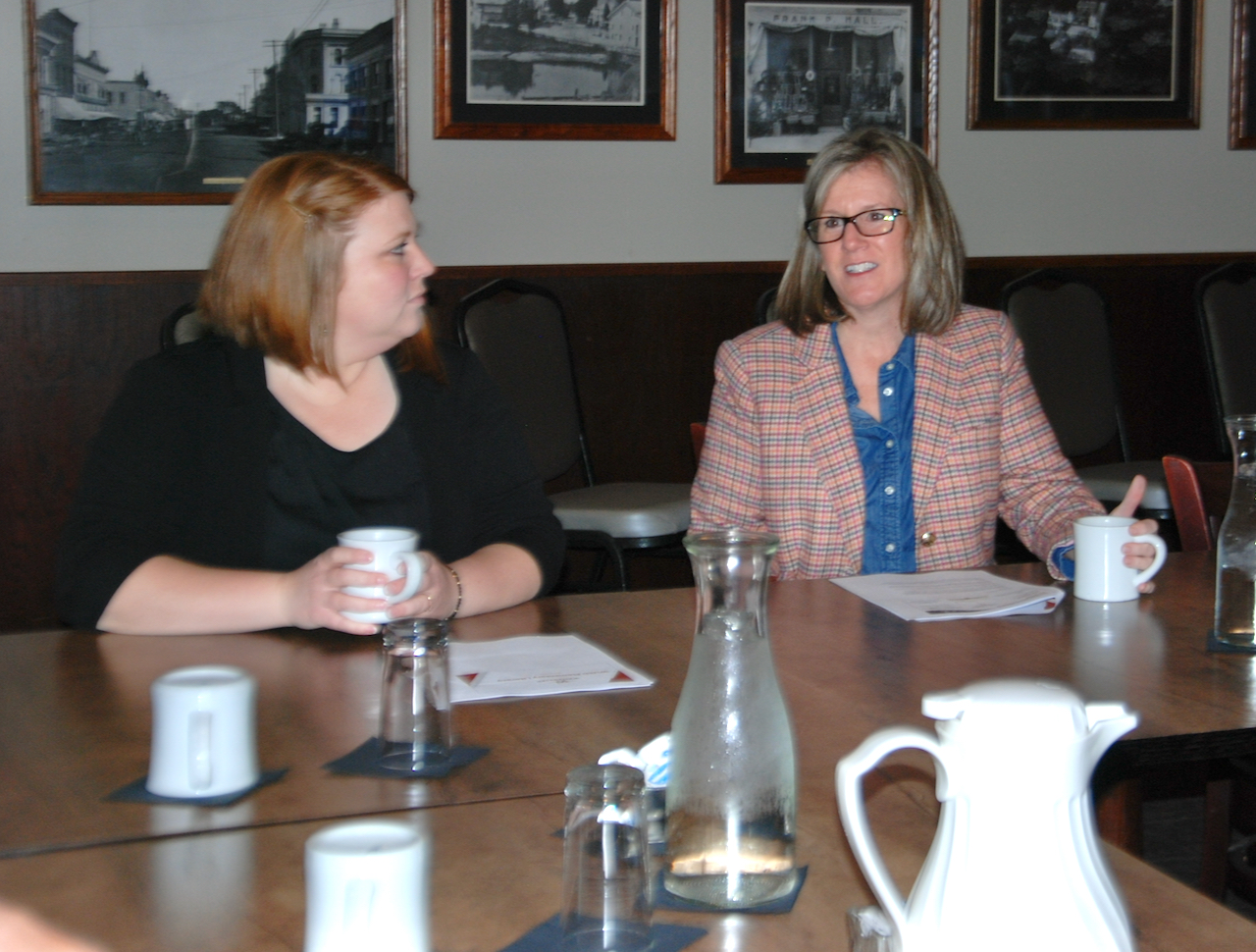
Addressing GWC, district superintendent says literacy growth K-5 stats show 40.9% of population proficient at mid-year 2023-24
By Kim McDarison
Whitewater Unified School District Superintendent Caroline Pate-Hefty and Director of Teaching and Learning Terilyn Robles Thursday told members of the community-based group the Greater Whitewater Committee (GWC) that the district’s K-5 literacy statistics are improving.
The two school district administrators served as speakers during the committee’s early morning monthly meeting.
The group invites members of the public, with reservations required, to attend its monthly meetings, which feature a speaker.
Some 25 group members and members of the public arrived Thursday to receive the superintendent and curriculum director’s presentation.
During the meeting, GWC President Jeff Knight, citing a question-and-answer period that would follow the presentation, asked attendees to remain focused on the topics of literacy, and literacy performance.
In advance of the presentation, Knight said that the GWC formed some 13 or 14 years ago, with a first initiative identified as lobbying the state for funds to make improvements to a segment of U.S. Highway 12, an east-west highway which connects the communities of Fort Atkinson, Whitewater, Elkhorn and Lake Geneva with the city of Madison.
Upon learning of a need to improve “academic excellence and standard performances for our kids,” Knight said the group changed its priority to focus on the identified need. The group formed a task force, Knight said, which met for six months. The result of the task force’s efforts was the formation of the Whitewater Leads program, he said, which he further described as a joint effort between the school district, the University of Wisconsin-Whitewater, the city of Whitewater, and the business community, to “help kids” to achieve literacy.
According to Knight, the group also was a facilitator in bringing information about the “Science of Reading” to the area, through its $1,500 co-sponsorship of a documentary film titled: The Truth About Reading.” Last July, through its passage of Act 20, the state mandated that Science of Reading become part of school curricula statewide.
Also in July, the GWC hosted as its keynote speakers two UW-Whitewater special education faculty members: Professor Lauren Zepp and Assistant Professor Lana Collet-Klingenberg, both of whom “educate(d) and advocate(d) for Science of Reading,” an announcement about the meeting released last July stated. A slide show used by the faculty members to explain the Science of Reading concept as presented to the GWC is here: http://whitewaterwise.com/wp-content/uploads/2024/04/GWC-Presentation-The-Science-of-Reading-1.pdf.
Diagnosing a district
Aided by slides, Pate-Hefty told those in attendance that she was “closing my third year here as superintendent in Whitewater.”
She described her commitment to the district from the perspectives of both an administrator and a mother, noting that she has three children attending school within the district.
“The decisions I make impact my kids. So I take that very serious in what I do. … what superintendents do is diagnose school systems; we look at the data, and what’s happening, and make recommendations,” she said, noting that she holds a doctorate degree.
Said Pate-Hefty: “Three years ago, looking at our data, we identified that there’s some real problems, and that’s the first step in making change in what we’re doing. So when you talk about diagnosing, two big numbers that you need to know is that the district was identified as almost hitting the 20% mark in special education. Special education — and I’m a special educator by trade — is the highest, most expensive service that we can give students that need it, but we are almost 10% — almost double the national average, 10-13% is where a district our size and outcomes would need to be, and so when I talk about being a doctor and diagnosing, there’s a problem there.
“So that says to me that we are looking at special education to meet student needs — because we are not meeting them — in a different way.”
Additionally, she said, the district had a second “big diagnostic problem, noting: “reading proficiency is at a 26% outcome, so 26% of our students were hitting the target. Where this number comes from is our Forward (Exam) data, that’s the state testing that we are required to take, on our state report card. Forward data on state report cards is an average of three years. So when you see our state report card come out this year, that (data) still includes the year after COVID.”
She continued: “So this was where we were when we started three years ago, 26% proficiency. We were not using other assessments to diagnose reading at that time, so that was a huge problem.”
Pate-Hefty said the the highest number of students with needs are students with reading disabilities.
Said Pate-hefty: “So when we talk about what we were providing for them, our reading materials were anywhere from five to 15 years old, and we were not providing consistent reading programming across the district. We have three elementary schools, and if you walked into a classroom three, four years ago, we could have been teaching different reading, even inside the school, because teachers were piecing together their reading materials. It just isn’t good practice.”
A change in direction
Last April or March, the superintendent said, the staff members presented to the district’s board of education “indicators of what was going on.”
She said board members agreed that something needed to change.
The result, she said, was a commitment to “start doing things consistently in the district.”
Pate-Hefty said the district began making changes even before the state’s Act 20 mandate.
Sharing the presentation, Robles offered a “brief overview” of the teaching approach titled: “Science of Reading.”
Reading from a slide, she said: “The body of work referred to as the ‘science of reading’ is not an ideology, a philosophy, a political agenda, a one-size-fits-all approach, a program of instruction, nor a specific component of instruction. It is the emerging consensus from many related disciplines, based on literally thousands of studies, supported by hundreds of millions of research dollars, conducted across the world in many languages. These studies have revealed a great deal about how we learn to read, what goes wrong when students don’t learn, and what kind of instruction is most likely to work the best for the most students.”
The slide noted that the description presented is attributed to Louisa Moats, a Harvard University Graduate of Education, Ed.D., and a nationally recognized authority on how children learn to read.
“I think this really nails down the idea that you cannot purchase one curriculum and that’s the Science of Reading curriculum,” Robles said.
Aided by a slide, she said the components of the science of learning include “curriculum and practices with the supports and the directions as students need. These are what research has shown us is most effective in connecting all of the parts of students’ brains so that we are systematically teaching our brains to read.”
Using a graphic which she dubbed a “reading rope,” Robles said the rope showed “the different components of what goes into that systematic instruction that’s supported by the curriculum, supported by intervention.”
Found “intertwined” within the reading rope, she said, were such skills and tools as language comprehension, background knowledge, vocabulary, language instruction, verbal reasoning, literacy knowledge, and word recognition, which, she said, “includes phonological awareness, decoding, and sight recognition.”
Said Robles: “All of those strands come together, and weave together, through instruction to produce skilled reading. We know that reading isn’t something that just comes naturally through exposure, but we have to incorporate each one of these parts of the reading rope, intertwine them, and do so explicitly in order to train our brains to read.”
Looking at a timeline slide, Robles said, last April, the district began exploring the concepts involved with science of reading, including a field trip to the Cudahy school district, where, she said, “we saw what was going on in other districts, and how they were moving their kids, how they were moving their data.”
She said the information was shared with school board members.
“We have that wonderful support from our board, and support from the community as we did the viewing of “The Truth About Reading,” just to learn about what that looks like for children and for adults, and then we started some pilots. So this year, in all three of our elementary schools, to bring that cohesion together, we piloted two different literacy curricula. One is “Wonders” and one is “Into Reading.”
Robles said the district was “in the final weeks of our second pilot, and so our teachers are getting that experience of teaching in the structured and explicit way … and we are seeing success.”
Within the “next couple weeks,” she said, the district would make a decision about which of its piloted materials it would adopt.
Pate-Hefty, too, spoke about the change is teaching materials, saying: “The piece behind that is that you are not just changing manufacturing parts, we were dealing with teachers who are really passionate about the work that they do. So I’m going to tell you there were a lot of tears in the beginning, and feeling like we failed kids for a long time. And that’s powerful in education because that’s not at the core of what we do. Starting in August … this process was emotional for people as we went through the journey. Our board did approve professional development that was costly, but critical to change the way that we were doing business, so that we know when a student is struggling now, that we are genuinely identifying them for special education needs for the right reason.”
Ahead of the curve
Pate-Hefty told meeting attendees that the district was “ahead of the curve” in applying the science of reading technology, citing a story about the district’s efforts published in the Wisconsin Association of School Board’s newsletter, “Policy Perspectives.”
She additionally shared information about a new assessment tool which the district was using, called: DIBELS (Dynamic Indicators of Basic Early Literacy Skills).
Said Pate-Hefty: “DIBELS is a diagnostic assessment in reading that gives very explicit data. Teachers cannot believe the detail. So we can tell if a student is making progress in phonetics, if they are making progress in each one of those pieces of the rope that Terilyn (Robles) just shared with you. We know where things are going wrong and can now intervene strategically. So we are using data to make decisions. So midyear, we are talking six months into the proposal, we’ve shown on the DIBELS, a 33% increase in K-5 students reading at or above grade level, and then 17% decrease in K-5 students reading below grade level. And that’s all students. So when we test on a DIBELS we test all of our kids. A link to a website page produced by the University of Oregon, titled, “Official DIBELS Home Page,” is here: https://dibels.uoregon.edu/#:~:text=DIBELS%20%C2%AE%20(Dynamic%20Indicators%20of,students%20in%20becoming%20successful%20readers.
“When you test on a Forward, that previous data we gave you, that (26%), your students who are newcomers from outside of the country are not tested for a year. So this is all kids. So when we move all kids, it’s going to improve our school system. So this is really powerful.”
The two officials next told attendees that they were able to share a new statistic.
Said Robles: “This is the newest number. So we do our benchmarks three times a year. So this is our midyear data that happened in January. We don’t have our end-of-year data yet.”
She anticipated, she said, that the year-end data would become available in May.
Robles continued: “So we are able to reference this in that first six months we are now at 40.9% proficiency among all of our K-5 learners. So inclusive of every single learner for this school year. This will have a major impact on that original number that Caroline (Pate-Hefty) is talking about. So that 26% number came from our Forward data. This number right here comes from our DIBELS data.”
Future goals
When the district embarked upon the new science of reading technology, Robles said, it set some goals.
She said: “back during that first presentation we gave to the board, we set goals based on projections and what we anticipated seeing, so we are really excited to see that 40.9%, because looking at our goals that were set at that time … we were set to project 52% proficiency (in the 2024-25 school year) and 70% proficiency (in the 2025-26 school year).
In the 2024-25 school year, “the district would have a full year of curricular implementation with the Science of Reading curriculum,” Robles said.
While the focus has been on elementary-level literacy, Robles said there has also been activity in the district’s secondary schools.
Among initiatives in the district’s secondary schools, grades 6-12, she listed: implementation of language- and vocabulary-focused statewide instructional strategies; academic support services available to all learners throughout the day with certified staff, and implementation of research-based literacy interventions at Tier 2 and Tier 3, including Systematic Instruction in Phoneme Awareness, Phonics, and Sight Words, The “Third Quest Reading” intervention, and “Language! Live: Literacy Intervention Program.”
“One of the reasons this was so necessary at the middle school level, when we pulled our data, we are talking again back to that diagnostician role, this school year there are 118 students in grades 6-8 (who) were performing in reading at the third-grade level,” Pate-Hefty said.
She noted that there are approximately 450 students at the middle school. Of that number, she said, (118) were performing at the third-grade level.
Henri Kinson, a resident in attendance during the presentation, asked: “Why is that?”
Said Pate-Hefty: “So, and that is when we talk about — those student who have come up through the reading programming, we actually pulled the data, and we are not talking about all MLs (Multilingual Learners), these are kids who have been in our system, that have not been caught through the reading process. Some of them identified as special education needs, and we didn’t know how to identify that in the past.”
She continued: “But this commitment is critical, from our board, and our administration because it’s not easy to teach a sixth- through eighth-grader reading, because they are embarrassed, they’re frustrated, they don’t want to be going back to sounding and spelling out words. We talk about the emotion about this and it’s critical, but we’ve committed to it, kids have committed to it. They are excited about their classes, they are participating in this process, but that commitment from this school district to our community is critical in saying, ‘hey, we’re not going to let those kids continue at a third-grade level.’ It’s hard work for our teachers. Typically, teachers, from the sixth grade up, are content certified, not reading certified. So that’s a whole new process for them to learn. So this has been quite an undertaking all at the same time.”
Questions
During a question-and-answer period, which was opened to GWC members first, followed by other attendees, Knight asked: What was the starting point about the rate of proficiency?
Said Pate-Hefty: “Our initial DIBELS … it was 33% increase, so we were at the 27 mark.”
Knight asked about opportunities for mentoring, additionally asking: “What can we do to help to make this even better?”
Pate-Hefty talked about the university’s efforts to teach teachers and the GWC’s help with sponsoring The Truth About Reading documentary.
She cited a “board approved program” into which the university “is feeding us in, with internships. So, for a very small price, we have students from the university come and have a 50% teaching role. It is a powerful experience for the students.”
She said student teachers participating in the program can “actually walk into their first jobs saying: ‘I’ve already done this work.’ And those interns are turning into future teachers.”
Responding to a question about reading specialists, Pate-Hefty said the reading specialist model has been shifted to “more of a coaching model, because what we know is that we’re not meeting the needs of all kids. This just isn’t a few kids slipping through the cracks that have needs, … we didn’t meet all of them.
“So we moved our reading specialists into reading coaches and they actually coach our teachers now. So they are going into the classroom with a literacy evaluation tool … and they’re giving teachers feedback.”
Knight noted that he believed the “literacy problem” was not specific to Whitewater, but nationwide.
Pate-Hefty agreed.
“I guess I’m not thrilled to hear that we are only at 40.9% proficiency. I want to hear a much more significant number,” Knight said.
Addressing Knight, Pate-Hefty said: “we are below as a country in general … when the world looks at us, we are not the innovators of education, but know that national tests like the NAEP (National Assessment of Educational Progress), that measure math and reading outcomes have shown significant drops in reading since COVID, so that is not different from Whitewater.”
Said Pate-Hefty: “The number one indicator of success in a classroom is how a teacher feels, if they can make a difference. We call that teacher efficacy. So when a kid comes in with a teacher feeling like, ‘I’m going to do this today,’ (that) is the biggest impact. So feelings matter. And just in March … (board member) Jen Kienbaum was at that meeting at Washington (Elementary School), and we had teachers in tears, saying: ‘I feel like I’ve failed kids for 20 years, because now the lightbulb is on. I see it happening.’”
GWC member and Whitewater Unified School District Board of Education member Larry Kachel asked about curriculum costs, noting that the state has set aside $50 million to help pay for half of a district’s costs associated with purchasing new curricula. He asked: “How is that process going?”
Robles called the process “interesting at the state level.”
“There was an original proposal for which curricula would be included from the Literacy Committee, and then DPI (Wisconsin Department of Public Instruction) took the list and added additional curricula, based on the rubric … and they augmented that list,” Robles said, adding: “And then that headed over to the (Wisconsin State Legislature’s) Joint Finance Committee (JFC), … and the JFC decided that they wanted to pull back from the DPI list and accept just the curriculum council list, and so that impacted a lot of districts who (had) the potential to receive up to 50% reimbursement, which is looking to be a lot less. So our two piloted curricula are on our DPI list and are not on that JFC list.”
Robles said the district would use ESSER (Elementary and Secondary School Emergency Relief) funds, to pay for new materials.
She credited “preplanning” on the part of the district to allow for the funding resource.
She said the district would not, however, be able to apply for the 50% reimbursement from the state because the curricula it is using did not make it onto the JFC list.
Knight asked the school officials to return to a future GWC meeting and talk about issues with attendance.
School Board member Lisa Huempfner, who also was in attendance, introduced the issue of attendance, saying it was of national concern since COVID-19. She additionally spoke about testing issues stemming from the state’s No Child Left Behind Act parameters, which, she said, unfairly impact students who come from backgrounds where English is not a first language.
Knight additionally asked the school officials to return with “comparable” statistics to see how the district’s students are preforming compared to neighboring districts.
Kinson interjected a comment, calling the district’s position, as compared with neighboring districts, “terrible.”
“We’ve got work to do,” Knight said.
Pate-Hefty agreed, saying, “We’ve got lots of work to do, and we are committed to it.”
Knight said that he believed people make decisions about where to live based on how a school district is performing.
Kinson and Pate-Hefty agreed.
Knight asked the school officials to return with updated “test results.”
Pate-Hefty, referencing the state’s Forward Exam scores, cautioned that those numbers would “not change overnight,” further noting that state report card scores were based on a three-year average.
“It’s going to take time,” she said.
“The needle is moving,” she said.
For those who wanted to help the district, Pate-Hefty said, “support our teachers. Support our schools. Give them feedback that you appreciate that they are working critically hard, moving kids.”
Pate-Hefty, responding to Knight’s request to come back to the GWC with test results, said the Forward data will be available from the state “around June, July, so we analyze it following that.”
Knight said the committee would plan to learn more in August or September.
Kinson said that Whitewater was still recovering from a decision made during the COVID pandemic to “shut down the schools,” which, he said was a decision made “unlike everybody else around here, so if you look at this now …”
Knight said the committee would be better able to analyze the district’s position compared to other schools when the officials returned in September.
Kinson said the district was losing students at a rate of “200 kids every year.”
Said Knight: “Today was just to hear this literacy piece. We all know this district has work to do.”
In other business:
• The group was reminded of an upcoming “Housing Round Table” discussion, which will be held Thursday, April 25, between 9 and 11 a.m., at the Whitewater University Innovation Center, 1221 Innovation Dr., Whitewater. Those invited to participate in the discussion, according to a flier, include: Whitewater Common Council Members, Whitewater Community Development Authority (CDA) members, realtors, and developers.
• Group members were presented with a 12-page handout about property assessments and their impacts on property taxes, titled: “Revaluation and Property Taxes: Do Higher Property Values Mean Higher Taxes?” The report was produced this month by Madison-based “Forward Analytics,” described on its website as a “Wisconsin-based research organization that provides state and local policymakers with nonpartisan analysis of issues affecting the state.” A link to the document is here: http://whitewaterwise.com/wp-content/uploads/2024/04/Revaluation-and-Property-Taxes-12-page.pdf.
• An announcement, reminding those in attendance that the annual “Spring Splash” will be held Saturday, April 20, was made.
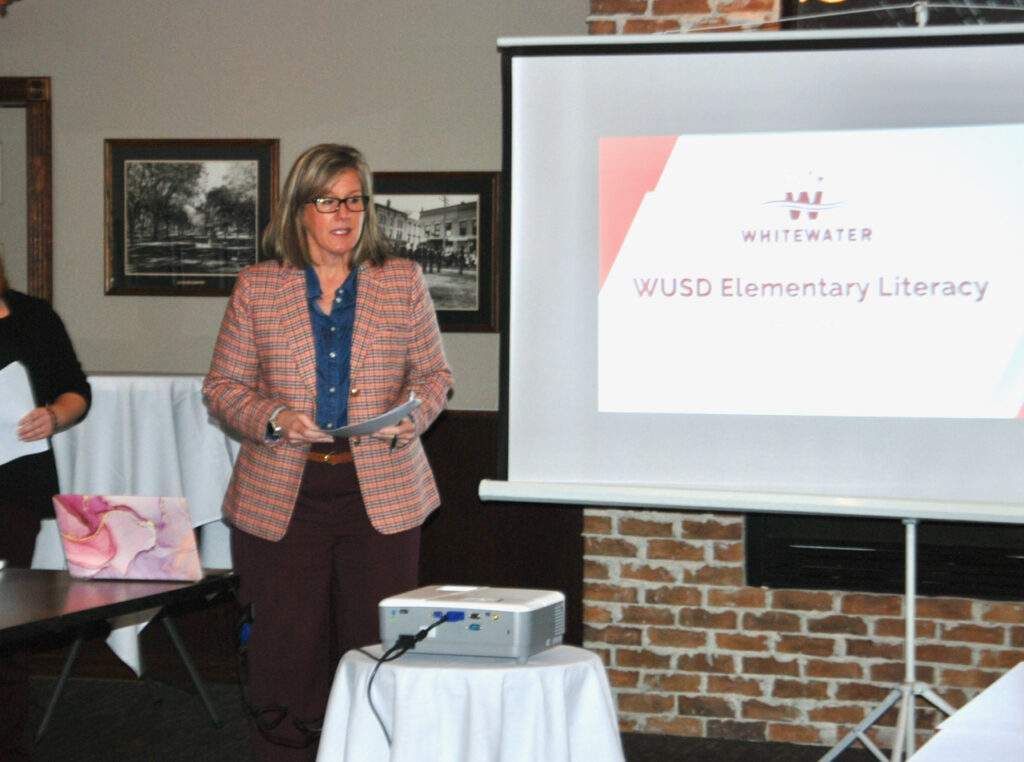
Whitewater Unified School District Superintendent Caroline Pate-Hefty addresses some 25 attendees of the Greater Whitewater Committee’s early morning monthly meeting. The superintendent talked about literacy proficiency within the district and the newly adopted Science of Reading format.
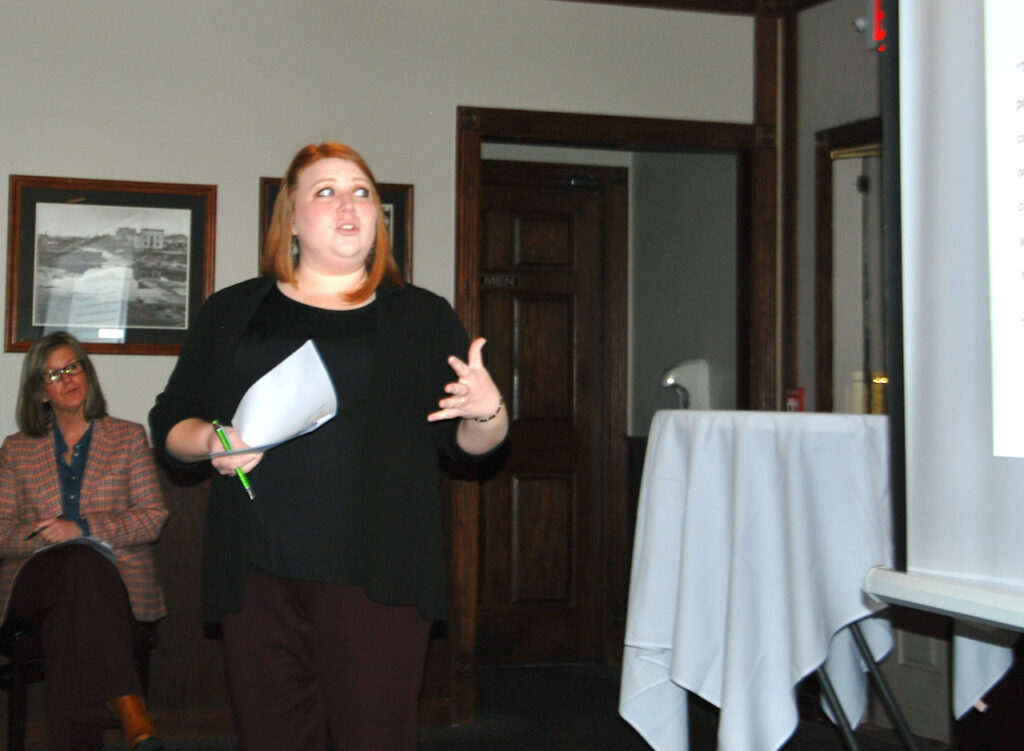
Terilyn Robles, the Whitewater Unified School District’s curriculum director, shares information defining the Science of Reading.
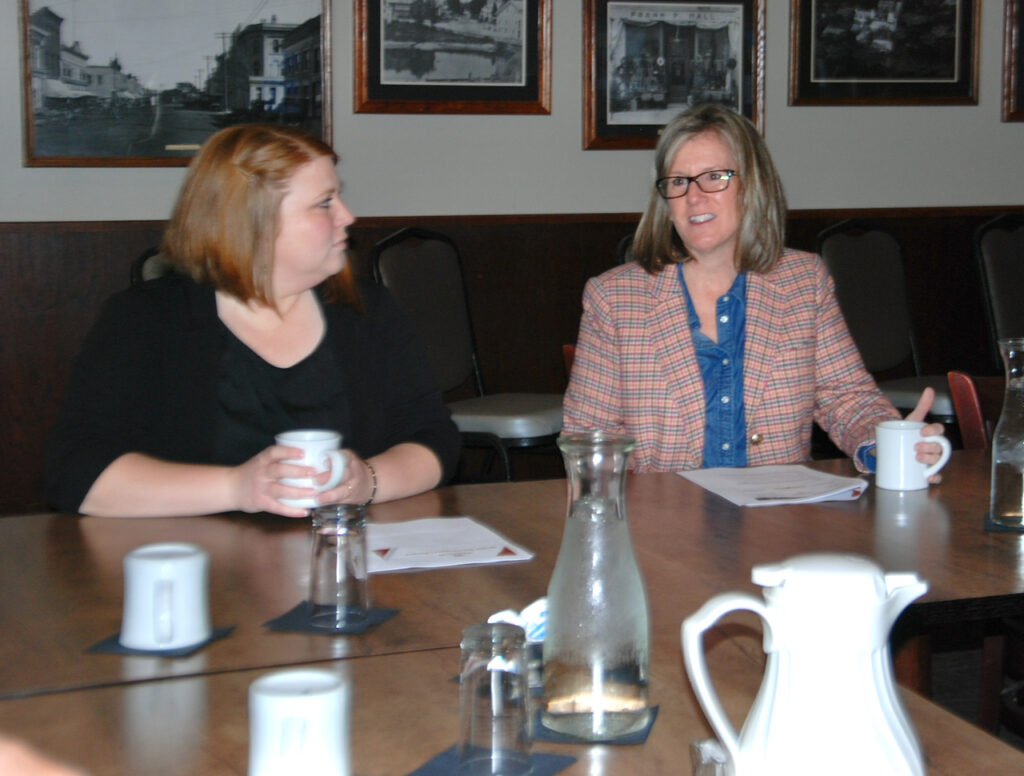
Whitewater Unified School District administrators, Director of Teaching and Learning Terilyn Robles, at left, and Superintendent Caroline Pate-Hefty enjoy coffee in advance of the monthly Greater Whitewater Committee meeting Thursday. The group’s monthly meetings are open to the public with a reservation and begin at 7 a.m. Kim McDarison photos.
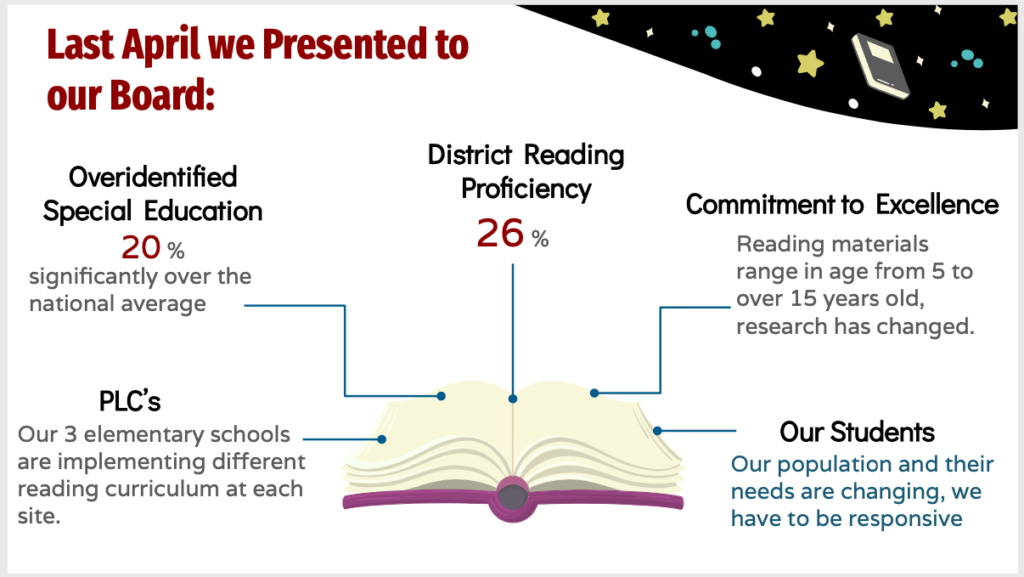
A slide offered during Thursday’s Greater Whitewater Committee meeting as part of a presentation made by Whitewater Unified School District Superintendent Caroline Pate-Hefty and the district’s curriculum director Terilyn Robles offers a “snapshot” of student literacy performance and the district’s reading program as presented last April to the district’s board of education.
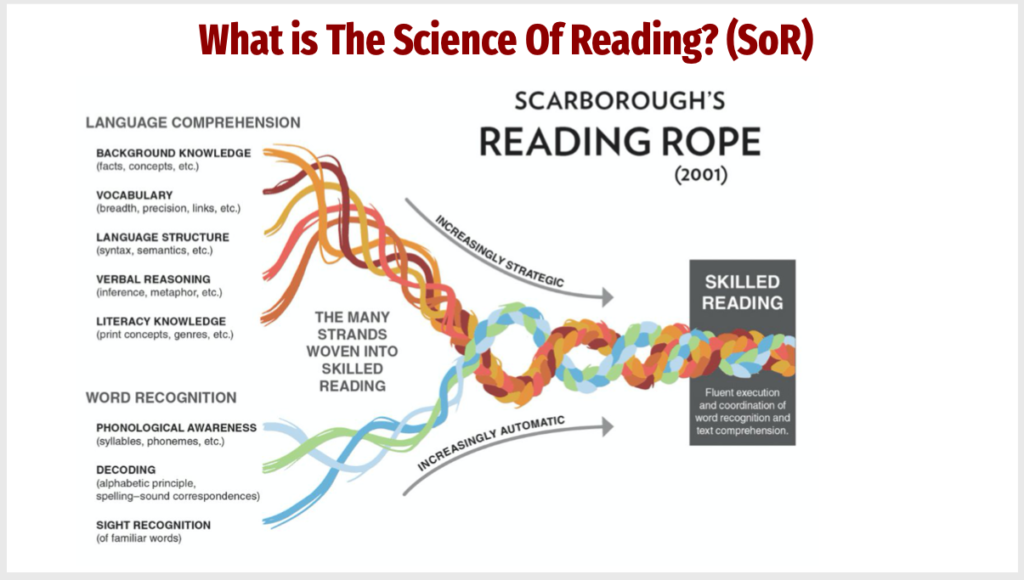
A graphic, depicting a “reading rope,” as presented to attendees during a Greater Whitewater Committee meeting Thursday, offers an understanding of the state’s recently mandated Act 20 literacy program, known as the Science of Reading.
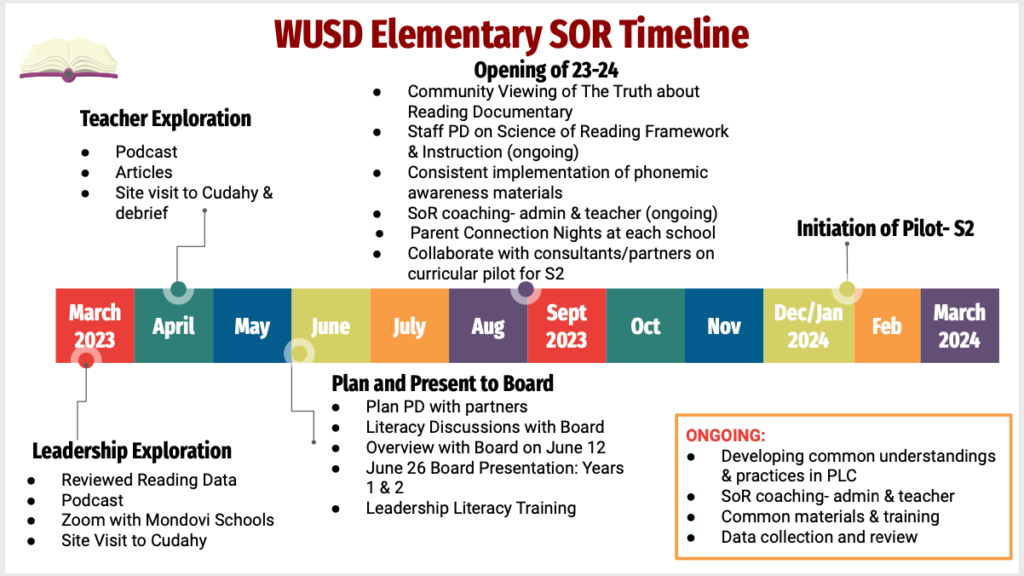
A slide presented Thursday to those attending a meeting of the Greater Whitewater Committee, shows a timeline that has been employed by the Whitewater Unified School District to bring the Science of Reading approach to literacy education to the district. The full slide presentation shared by district officials Thursday is here: http://whitewaterwise.com/wp-content/uploads/2024/04/WUSD-Elementary-Literacy-Greater-Whitewater-4_11.pdf.
This post has already been read 1528 times!
Kim
One thought on “Addressing GWC, district superintendent says literacy growth K-5 stats show 40.9% of population proficient at mid-year 2023-24 ”
Leave a Reply Cancel reply
Our Advertisers
Most Read Posts
Categories
- Advertisers
- Area events
- Art, culture
- Business
- Community
- County
- Crime, court
- Culture
- Diseases
- Economics
- Food
- Government
- International
- Law and Court
- Lifestyle
- Obituaries
- Opinion
- Police, fire, EMS
- Religion
- School
- Science
- Technology
- Today's features
- Today's news
- Top Stories
- Travel
- Uncategorized
- University
- World












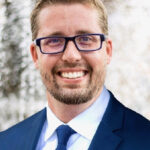
They identified the kids couldn’t do reading math or science. Gee, it’s only been shouted from the rooftops for years! This disgrace of a superintendent makes it sound like it was some newfound hidden secret 🙄
In a word, PATHETIC!